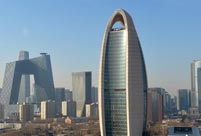 Int'l Snow Sculpture Art Expo in Harbin
Int'l Snow Sculpture Art Expo in Harbin Sichuan money wall for dividend payment
Sichuan money wall for dividend payment Li Na crashes Belinda Bencic in 2nd round at Australian Open
Li Na crashes Belinda Bencic in 2nd round at Australian Open
 Shocking moments when PLA's weapons open fire
Shocking moments when PLA's weapons open fire Famous Lanzhou beef noodles
Famous Lanzhou beef noodles Armed Police hold anti-terrorism drill in SE China's Xiamen
Armed Police hold anti-terrorism drill in SE China's Xiamen Harbin Int'l Ice and Snow Festival opens
Harbin Int'l Ice and Snow Festival opens 'Jin' named the word of the year by cross-strait netizens
'Jin' named the word of the year by cross-strait netizens Chinese scientific expedition goes to build new Antarctica station
Chinese scientific expedition goes to build new Antarctica station
BEIJING, Jan. 27 -- Although China's economy managed to end a somewhat turbulent 2013 on solid footing, a shaky start this year, as shown in new manufacturing data, has renewed worries over its growth prospects.
The flash reading for the China manufacturing Purchasing Managers' Index (PMI) dropped to 49.6 in January, falling below the 50-threshold that demarcates expansion and contraction and marking the lowest point in six months, a preliminary HSBC survey showed.
As the first available hint on economic performance for the new year, the data does not bode well for the world's second-largest economy as 2014 marks the first year for China to deliver its reform promises, entrenching doubts among some skeptics that the country may still face the likelihood of falling into a "middle-income trap" or even experiencing a hard landing.
The HSBC data came on the heels of China's growth figure that showed the economy expanding 7.7 percent in 2013, overshooting the official target of 7.5 percent.
The government has yet to announce its 2014 growth target, which analysts widely expect to be set at 7 percent or 7.5 percent.
But as the focus of the authorities is now turned to forging a more sustainable model, the task this year -- the search for a "golden balancing point" -- requires more sophisticated consideration and efforts.
Although the headline GDP growth remains stable, analysts have already noted an easing trend in the sequential growth momentum since the fourth quarter last year.
"The drop in HSBC PMI reinforces the trend of softening growth momentum, and we expect the momentum to ease further to 7.2 percent on a quarterly basis in the first quarter of 2014 and 6.8 percent in the second," said a J.P. Morgan research note.
The bank attributed the slowdown partly to China's adjustment of policy focus from growth to structural reforms, including allowing a slower pace of credit growth to contain government debt.
The new policy stance was made clear at an annual tone-setting economic conference last year in which the government pledged to maintain continuous and stable economic policy while pushing forward reforms to achieve "reasonable growth" this year.
As long as the economy is running within that range, marked by a lower limit designed to ensure steady growth and job creation and an upper limit meant to avert inflation, the government will place its focus on structural adjustment.
Shortly after the meeting, China made public its total government debt, in a demonstration of its resolve to face and handle the looming problem that is deemed a major threat to national economic health.
But although the broader direction is clear, opinions have diverged on how the tradeoff between growth and reforms will play out in 2014, as some reforms, such as eliminating excessive capacities and deleveraging the economy, would possibly incur a negative impact on short-term growth.
One prominent area for the tradeoff is in the financial market. While the liberalization of China's interest rate will benefit the economy in the long term, it is also likely to trigger a rise in default cases and threaten overall financial stability in the short term.
"Though we don't expect nationwide debt and a banking crisis, we believe the chance of some bond and trust loan defaults will rise significantly in 2014, especially as the more confident government sees need for some defaults to develop a more disciplined financial market," said a note from a research team with the Bank of America Merrill Lynch led by chief China economist Lu Ting.
Despite the risks, Lu still believes China's confident leadership will be able to push for a wider range of reforms, including fiscal and administrative reshuffles, to deliver a more stable growth in 2014.
Changes are already happening in the economy. In a report on China's growth outlook, Barclays noted a few positive structural changes, such as reduced rural-urban inequality and regional disparity, as well as growth in the services industry.
Official data showed China's rural household per capita income growth continued to outpace that of urban households in 2013, and the service sector share of GDP has risen to 46.1 percent, exceeding that of manufacturing for the first time.
"We expect the rebalancing between consumption and investment will take place gradually as the savings rate declines," Goldman Sachs said in its China 2014 outlook report last month, adding the fiscal and social policies should be the key instrument to help strengthen consumption.
"Nonetheless, reform is more likely to be gradual and implementation of the agenda will be carefully sequenced to manage the net impact on overall growth," according to J.P. Morgan.
 A 60-hour journey home
A 60-hour journey home Int'l Snow Sculpture Art Expo
Int'l Snow Sculpture Art Expo Highlights of China's air force
Highlights of China's air force Airline crew stage flashmob dance at Kunming airport
Airline crew stage flashmob dance at Kunming airport Top15 countries to retire to in 2014
Top15 countries to retire to in 2014 Hot supermodel's new photo album released
Hot supermodel's new photo album released Asia's heaviest box girder finishes 'rotation' in Wuhan
Asia's heaviest box girder finishes 'rotation' in Wuhan Completed facade of People's Daily new headquarters
Completed facade of People's Daily new headquarters Chinese-branded car passes North America standard safety test for the first time
Chinese-branded car passes North America standard safety test for the first time Li Na beats Bouchard to reach Australian final
Li Na beats Bouchard to reach Australian final  Explore the sources of PM 2.5
Explore the sources of PM 2.5 Highlights of Chinese airborne troops'exercises
Highlights of Chinese airborne troops'exercises  'Living in ice house' competition held in central China
'Living in ice house' competition held in central China  Chinese figure in Oscar nominations
Chinese figure in Oscar nominations  Top ten aerospace events in China 2013
Top ten aerospace events in China 2013Day|Week|Month